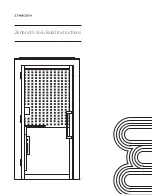
Amino Acid Deletions
Mass Difference
Reason
Mass Difference
Reason
Mass Difference
Reason
-71
-Ala
-57
-Gly
-97
-Pro
-156
-Arg
-137
-His
-87
-Ser
-114
-Asn
-113
-Ile
-101
-Thr
-115
-Asp
-113
-Leu
-186
-Trp
-103
-Cys
-128
-Lys
-163
-Tyr
-128
-Gln
-131
-Met
-99
-Val
-129
-Glu
-147
-Phe
Side Reactions
N-terminal Modifications
Mass Difference
Reason
Mass Difference
Reason
-18
Aspartimide
+223
Fmoc
+67
Aspartimide
+42
N-Acetyl
+101
Tetramethylguanidium
Salts
Because peptides are charged molecules, the target is often detected as a salt when analyzing peptides by ESI-MS.
Mass Difference
Reason
+23
Na+ salt
+39
K+ salt
+114
TFA salt
+46
Formic salt
Liberty Blue Accessories
HT12 and HT24 Resin Loader
The HT12 and HT24 resin loaders increase the throughput of the Liberty Blue system by adding a modular resin loading
option with up to 24 positions.
Reaction Scale for Resin Transfer
• The resin transfer option is intended for syntheses at 0.1 or 0.25 mmol scale (0.25-1.0 g of resin).
• The resin transfer option should only be used with the 30-mL reaction vessel. This option has not been optimized by CEM
for use with the 125-mL vessel.
Transfer Solvent
The transfer solvent is used to move the resin into and out of the reaction vessel, and to swell the resin. The
recommended transfer solvent is 50% DMF/50% DCM by volume. This mixture will ensure optimal suspension of the resin
for efficient transfer.
It is important that approximately 10 mL of transfer solvent is added to the resin tube before loading resin on the system
for swelling, with the exception of
Cl-TCP(Cl) ProTide and Cl-MPA ProTide
. The Cl-TCP(Cl) ProTide and Cl-MPA ProTide resins
can hydrolyze, reducing yield, and should not sit in the swelling solvent for prolonged periods of time.
These resins are the
only resins that should be loaded onto the HT module without solvent.


























